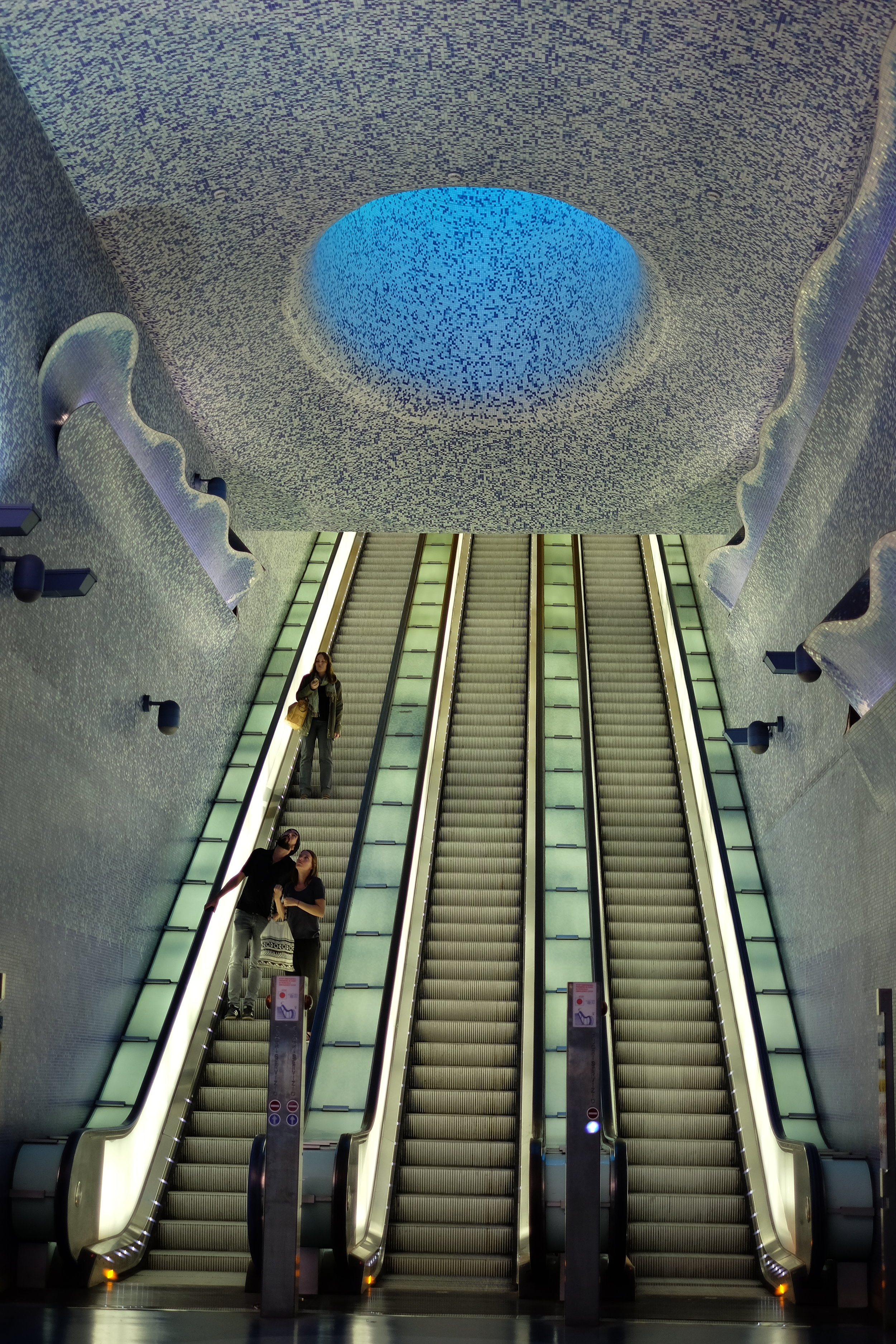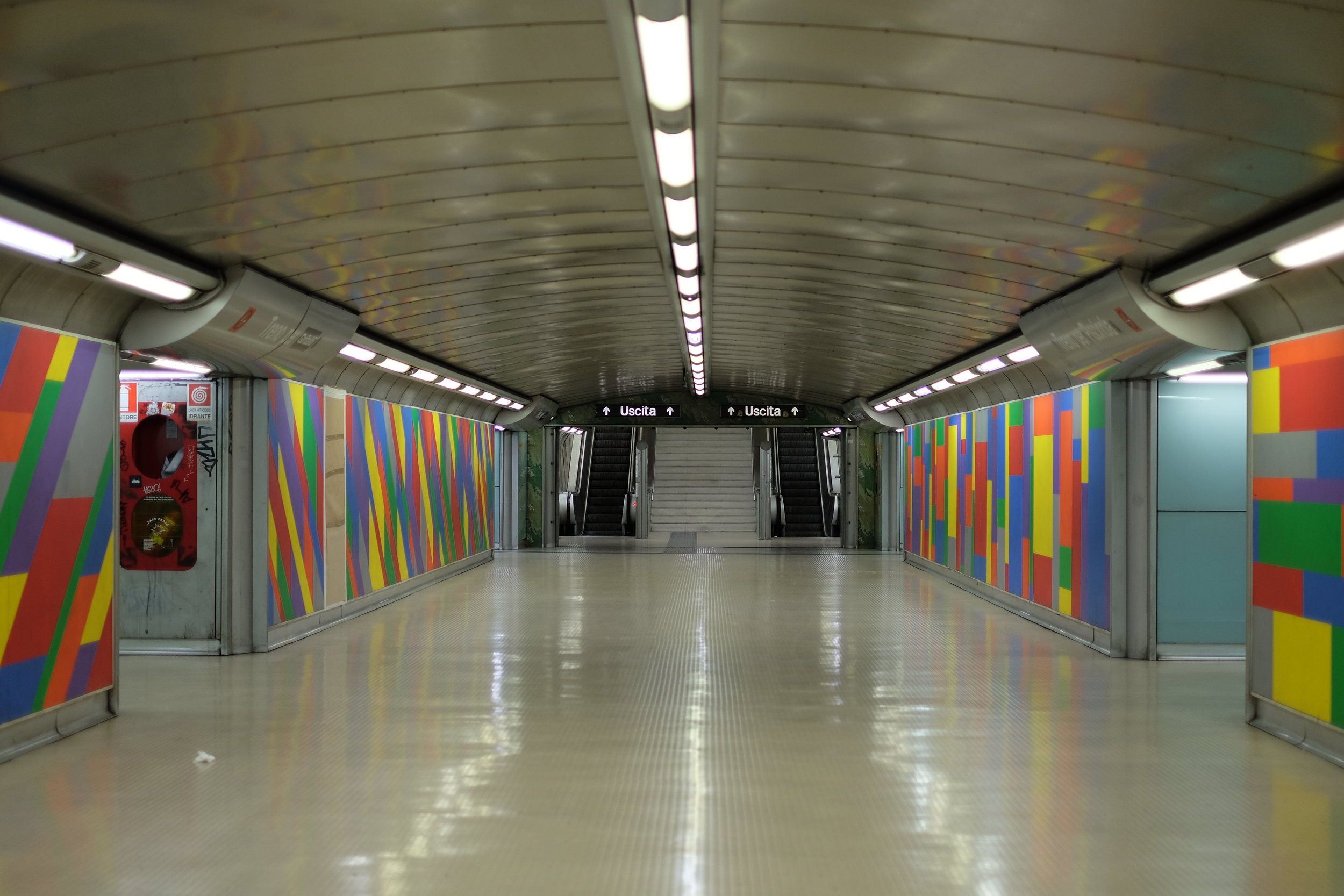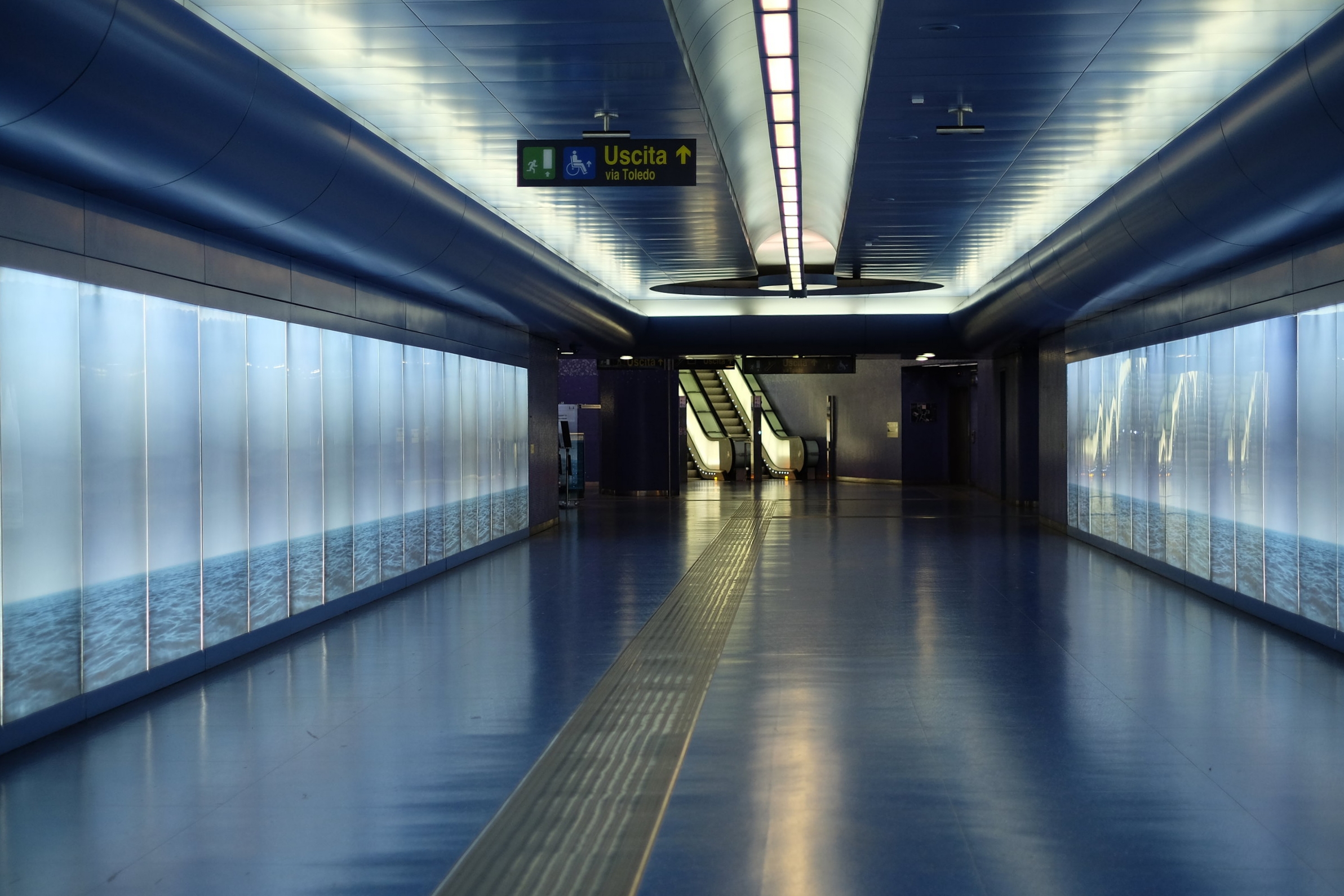Toledo station in via Toledo.
Napoli is not only a unique city on the surface, but also going into its depths you can discover another fascinating city. Under Napoli, there is a universe that goes from the greek foundations through the roman ruins and up to the modern day Metro. I will write about the complex city of catacombs, tunnels and aqueducts in my next post, but In this one I will talk about the metro underground train system, or metropolitana which is how we call it in Italian. Considered one of the most beautiful underground systems in Europe, the metro has received a lot of recognition all over the world, including pieces in the British Daily Telegraph and America's CNN.
You might say "but it's only a metro station!". Well, it is far from being an ordinary metro station. it's stations are definitely different from any other city in the world. Every station of the Linea 1 is a unique contemporary 'art gallery' with each station displaying contemporary art from some of the the most recognized and celebrated artists of the present day. A labyrinth of tunnels and art galleries with references to the history and culture of the city.
Linea 1 (Line 1), which connects Vomero with the centre of the city, started in the 1970's but was often interrupted due to earthquakes and archealogical finds. In 1995, The Comune di Napoli (Council of Napoli) decided to create spaces of "beauty" in the every-day-neapolitan-life. The new metro stations offered the perfect space in order to make people more engaged to the contemporary artistic scene, so it was called the 'Stazioni dell'arte' (Stations of art). Along the stations of the metro there are more than 200 works of art created specifically for those spaces.
The Municipio station, started in 2003 and still going on for over a decade is definitely the most problematic and challenging of all the stations of the metro. The station is now opened but there are still archealogical works still going on due to the incredible and enormous number of archeological artefacts found in the area. In fact, this area was in roman times the port and during the centuries the sea has reseeded where now the square is. Archeologists have found the remains of a thermal spa, the old fortifications of the city, a tower of the Aragon era, a palace and even five roman ships. Many artefacts are on display inside the station.
The first station opened was Vanvitelli station, at the top of the Vomero hill and one of the busiest stations of the metro. Here artificial and natural light combine with signage in shades of blue, purple, yellow and grey. The corridors that take the people from the streets to the trains are decorated with works of art by Neapolitan artists.
In 2001, more art stations were opened including Museo, Salvator Rosa and Quattro Giornate.
The Museo (Piazza Cavour) station, the stop for the Archeological Museum, was a project by the architect Gae Aulenti. The theme is related to the museum and the artefacts inside: corridors and tunnels in red and glass harking back to Pompeiian villas, a copy of the Hercules at rest, made by the Art Academy nearby. The corridors that lead from the train to the museum are darker with the photographs of roman statues by the artist Mimmo Jodice. At the entrance of the station is a copy of the roman statue 'Laocoön'. In the other corridors on display are artefacts found during the building works of other stations.
Salvator Rosa station is the perfect example of the connection between the metro and its surroundings, where even the buildings outside have been decorated in the style of the station. Here many important Neapolitan and Italian contemporary artists have collaborated, just to name a few; Ernesto Tatafiore, Gianni Pisani, Mimmo Rotella, Mimmo Paladino and Renato Barisani. Mosaics, volcanic stones, red, blue and brightly coloured tiles and golden marble welcome every day, workers, students and tourists. The entrance is through a playground where there are art installations by Alex Mocika, Augusto Perez, Renato Barisani, Lucio Del Pezzo, Nino Longobardi, Riccardo Dalisi, Ugo Marano. From here the entrance to the station is through a huge pyramid in glass that references the guglie, the columns with saints in the city.
Quattro Giornate station is on the eastern part of the Vomero, where the old stadium is. Outside the station are statues in bronze and steel of athletes by Lydia Cottone. The name quattro giornate is related to the historical event of the uprising of the Neapolitans against the Nazi's in September 1943. At the entrance of the station there are statues by Nino Longobardi which remembers this episode.
In 2002, two more stations were opened: Rione Alto station and Piazza Dante.
The Piazza Dante station is another busy station that serves the historical centre. The architect Gae Aulenti created a station which echoed the 17th century square. The result is quite impressive; the architect created many entrances to the station from every side of the square, transparent walls contrast with the volcanic stones of the square created by the architect Vanvitelli. Once inside the station, the artist Joseph Kosuth welcomes people with his neon quotes on the walls by the famous writer Dante, who the square is named after. While going through the escalator there are works by Jannis Kounellis and Michelangelo Pistoletto.
Entrance to the ticket hall with neon quotes by Dante.
Colourful walls os Dante station.
Installation in Dante station.
Materdei station was opened in 2003, and is another interesting metro station. Outside is an area completely closed to the traffic with a playground, a little park and many art installations. Inside the station are many symbols of Neapolitan culture and characters from folklore of the city. Platforms are decorated with wall drawings by Sol LeWitt and photographic installations.
Materdei station platform.
Bright colours and photographic panels.
Photographic installation.
Platform level.
Under the pyramid of Materdei Station.
The Universitá station which serves the university area was opened in 2011 and is a project by the architects Karim Rashid and Alessandro Mendini. Here different materials are used, such as glass, steel and mirrors, with pink, purple and lime green colours. Going down to platform level the space is created with digitally designed tiles and a light box with the words of the florentine poet Dante. Again, past and present, Renaissance and contemporary collide.
One of the most impressive and my personal favourite is, Toledo station designed by the Spanish architect Óscar Tusquets Blanca, opened in 2012. Not a coincidence that the architect is Spanish as from the station it is possible to get to the Spanish Quarters (Quartieri Spagnoli) one of the oldest parts of the city. It is a journey into the depths of the city (50 meters), like into the depths of the sea. The outside of the station is Via Toledo, the main shopping street of Napoli, here is the statue of The Knight of Toledo by the artist William Kentridge.
The internal space of the station is decorated with volcanic stone and big orange circles with the first floor down echoing the ancient town walls of the Aragons. There are mosaics by William Kentridge (Naples Procession) picturing the opening of the first train station in the city in 1906. As you go deeper down into the station you come across another important element of the city, the sea. On the second floor down, the walls become dramatically calm with the colours of blue and white . The more deeper you go the more bluer it gets becoming dark blue like the abyss of the ocean. Looking up you can admire the impressive cone, Crater del luz, crater of light that with a display of LED lights gives the impression of the waves. The artist Robert Wilson created the panels of the corridors to the platforms named "By the sea... you and me", which are series of lenticular photographs of the sea in movement. The artist Achille Cevoli created a panel dedicated to the builders who made this station possible entitled Men at work.
The mosaic 'Naples Procession' by William Kentridge at Toledo station.
Toledo station: from the ground down to the sea.
The crater of lights in Toledo station.
Waves inside the Toledo station.
"By the sea... you and me" by Robert Wilson at Toledo Station.
The newest station is Garibaldi. This is the connection at the main train station and was a project by the French architect Dominique Perrault. The space is all in one structure, full of lights where the escalators and the people look like they are suspended on the mirrored walls. The internal part is decorated with shiny panels in steel. In here are two installations by the artist Michelangelo Pistoletto. In this station the platforms are inspired by the London Underground.
The newest metro line is Linea 6, connecting Municipio, Chiaia, Mergellina and Mostra (Fuorigrotta area).
The Chiaia metro station has been curated by the film director Peter Greenway and for its architecture and design has been given the award for the most beautiful metro station in the world by the Prix Versailles organisation.
Exit to the street from Garibaldi station.
The metro, like in all other cities, will always be extended and improved, connecting more areas with the centre of the city and it will give more chances for artists to collaborate in a unique project. The metropolitana of Napoli has became famous all over the world. Neapolitans and tourists love it and of course, artists enjoy the opportunity to create unique spaces that can inspire the travelling public. It is actually a very romantic notion to think how these works of art connect with so many people, wherever they are going to and wherever they are coming from, on Napoli's unique Metropolitana.
For further info about timetables and stations click here in the section TRAVEL INFO.




















